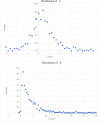This is a preprint.
A generalisation of the method of regression calibration
- PMID: 37645976
- PMCID: PMC10462182
- DOI: 10.21203/rs.3.rs-3248694/v1
A generalisation of the method of regression calibration
Update in
-
A generalisation of the method of regression calibration.Sci Rep. 2023 Sep 13;13(1):15127. doi: 10.1038/s41598-023-42283-y. Sci Rep. 2023. PMID: 37704705 Free PMC article.
Abstract
There is direct evidence of risks at moderate and high levels of radiation dose for highly radiogenic cancers such as leukaemia and thyroid cancer. For many cancer sites, however, it is necessary to assess risks via extrapolation from groups exposed at moderate and high levels of dose, about which there are substantial uncertainties. Crucial to the resolution of this area of uncertainty is the modelling of the dose-response relationship and the importance of both systematic and random dosimetric errors for analyses in the various exposed groups. It is well recognised that measurement error can alter substantially the shape of this relationship and hence the derived population risk estimates. Particular attention has been devoted to the issue of shared errors, common in many datasets, and particularly important in occupational settings. We propose a modification of the regression calibration method which is particularly suited to studies in which there is a substantial amount of shared error, and in which there may also be curvature in the true dose response. This method can be used in settings where there is a mixture of Berkson and classical error. In fits to synthetic datasets in which there is substantial upward curvature in the true dose response, and varying (and sometimes substantial) amounts of classical and Berkson error, we show that the coverage probabilities of all methods for the linear coefficient \(\alpha\) are near the desired level, irrespective of the magnitudes of assumed Berkson and classical error, whether shared or unshared. However, the coverage probabilities for the quadratic coefficient \(\beta\) are generally too low for the unadjusted and regression calibration methods, particularly for larger magnitudes of the Berkson error, whether this is shared or unshared. In contrast Monte Carlo maximum likelihood yields coverage probabilities for \(\beta\) that are uniformly too high. The extended regression calibration method yields coverage probabilities that are too low when shared and unshared Berkson errors are both large, although otherwise it performs well, and coverage is generally better than these other three methods. A notable feature is that for all methods apart from extended regression calibration the estimates of the quadratic coefficient \(\beta\) are substantially upwardly biased.
Conflict of interest statement
Figures


Similar articles
-
A generalisation of the method of regression calibration.Sci Rep. 2023 Sep 13;13(1):15127. doi: 10.1038/s41598-023-42283-y. Sci Rep. 2023. PMID: 37704705 Free PMC article.
-
A generalisation of the method of regression calibration and comparison with Bayesian and frequentist model averaging methods.Sci Rep. 2024 Mar 19;14(1):6613. doi: 10.1038/s41598-024-56967-6. Sci Rep. 2024. PMID: 38503853 Free PMC article.
-
A generalisation of the method of regression calibration and comparison with Bayesian and frequentist model averaging methods.ArXiv [Preprint]. 2024 Mar 13:arXiv:2312.02215v3. ArXiv. 2024. Update in: Sci Rep. 2024 Mar 19;14(1):6613. doi: 10.1038/s41598-024-56967-6. PMID: 38196750 Free PMC article. Updated. Preprint.
-
Methods to account for uncertainties in exposure assessment in studies of environmental exposures.Environ Health. 2019 Apr 8;18(1):31. doi: 10.1186/s12940-019-0468-4. Environ Health. 2019. PMID: 30961632 Free PMC article. Review.
-
Effect of measurement error on epidemiological studies of environmental and occupational exposures.Occup Environ Med. 1998 Oct;55(10):651-6. doi: 10.1136/oem.55.10.651. Occup Environ Med. 1998. PMID: 9930084 Free PMC article. Review.
References
-
- United Nations Scientific Committee on the Effects of Atomic Radiation (UNSCEAR). UNSCEAR 2006 Report. Annex A. Epidemiological Studies of Radiation and Cancer. (United Nations, 2008).
-
- Armstrong B. et al. Radiation. Volume 100D. A review of human carcinogens., (International Agency for Research on Cancer, 2012).
Publication types
Grants and funding
LinkOut - more resources
Full Text Sources

